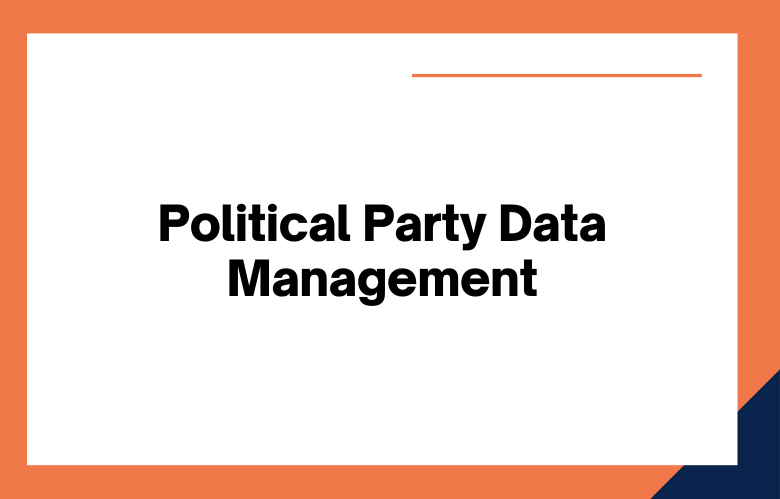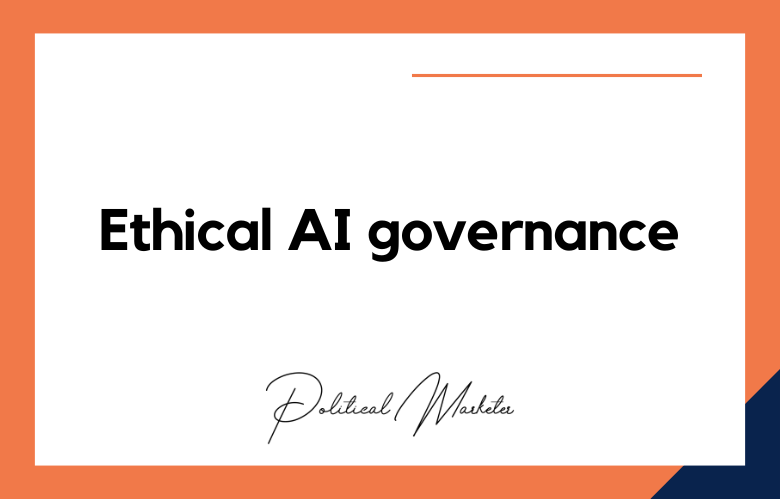A political party’s data is one of its most valuable assets. The best practices for managing this data are critical to the party’s success. We discuss the best practices for political party data management. We will also highlight some of the challenges that parties face when it comes to managing their data. Finally, we offer some tips on how to overcome these challenges.
Party data management is critical to the success of any political campaign. Using the best practices for party data management, you can ensure your data is clean, accurate, and organized. It helps you target voters more effectively and boost your chances of winning on election day. Here are some tips to improve your party data management strategies.
What is a Political Party Data Management?
Managing data for a political party can be a daunting task. Many data types, such as campaign finance reports, voter information, and poll data, must be considered. Political parties need a system to track all this information and ensure it is accessible to those needing it.
Political party data management involves organizing and maintaining information related to a political party. It includes voter data, fundraising records, and event information.
An effective political party data management system can make it easier for a party to keep track of its supporters, raise money, and plan events.
A political party, data management system is a political tool parties use to collect, track, and manage information on their members and supporters.
This system lets parties keep track of important information such as contact details, membership dues, and donations.
It also allows parties to communicate with their members and supporters and coordinate activities and events.
The party data management system is an essential tool for any political party that wants to be successful.
Political Party Data Management is the umbrella term for how a political party gathers, stores, and uses data. It includes voter registration data, donor information, volunteer records, purchasing/expense data, and more. Each political party has its way of handling this data, but some standard methods and tools use.
In short, it is the organization and collection of data related to a political party. It includes voter data, fundraising data, contact information, event data, and more. Proper data management is essential to Effective campaigning and can give a party a significant advantage over its opponents.
Data management for political parties is organizing and storing party data in a way that is efficient and accessible. By managing party data, parties can more effectively communicate with voters, keep track of members, and stay organized.
Political Party Data Management is a term used to describe organizing and storing data for a political party.
This data can include contact information for party members, financial information, and other records.
A sound data management system is essential for a political party to keep track of its members and run its operations effectively.
Best Practices for Political Party Data Management
Party data management is crucial for any political party looking to stay competitive. Here are some best practices to keep in mind:
Ensure that you have a dedicated team to manage party data. This team should be responsible for keeping track of party member information, voter data, and campaign finance records.
Use specialized software to help with party data management. This software can make collecting, cleaning, and analyzing data more accessible. Several software options are available, so find one that meets your party’s specific needs.
Be sure to monitor and update your data regularly. Changes in demographics, voting patterns, and campaign strategies can impact how you manage your data.
Create a central database to track all incoming and outgoing money.
Designate specific staff members to be in charge of updating the database.
Develop a system for organizing and categorizing expenses.
Make sure to cross-check all data against financial reports.
Periodically review and update procedures as needed.
Adherence to best practices to manage data for political parties effectively is essential. These best practices include maintaining accurate records, securing data, and backing up data regularly.
Establishing transparent and efficient procedures is the best way to manage data for political parties.
Creating clear and concise procedures is one of the most critical factors in ensuring efficient data management.
Clear and concise procedures When it comes to data management for political parties, setting up systems is critical to making the process more effective.
Procedures By having procedures in place, it will be easier to maintain control over the data and avoid compliance issues.
It is essential to keep track of all communication with voters. It means creating a system to store contact information, whether it is digital or physical.
It is crucial to document every interaction with voters. It helps parties understand what issues are important to their voters and where they need to focus their efforts.
Parties should always be prepared to share their data with other organizations, such as media outlets or research groups. It allows them to get their message to a broader audience and show transparency in their practices.
It is essential to have a clear and concise database structure. It will make it easier to query data and generate reports. Secondly, data should be accurately coded and updated regularly. It helps avoid errors and ensures that the data is up-to-date.
Effective data management also requires good communication and coordination among team members.
The best practices for political party data management are constantly evolving. As new technologies and methods introduce, parties must adapt to keep pace with the competition.
Staying on top of data can be challenging for any organization, but it is incredibly complex for political parties. They must keep track of voter information, donor history, event logistics, and more.
However, by implementing a few best practices, they can ensure that their data manage correctly.
One crucial best practice is to appoint a dedicated data manager. This individual will be responsible for organizing and maintaining the party’s data.
Another best practice is creating a central database to store and access all the party’s data. It makes it easier for everyone to find the information they need.
Maintaining accurate and up-to-date records is essential for political party data management. It means regularly scrubbing the database to ensure accuracy and completeness.
Data security is another critical best practice for political party data management. It includes ensuring that only authorized personnel have access to the data and that all data is encrypted.
Making data accessible to party members is also essential. It is to provide self-service options for accessing data or training staff on how to use it effectively.
- Establish a data management system.
- Collect voter data from various sources.
- Clean and standardize the data
- Store the data in a secure location
- Use the data to target voters and support your party’s campaigns
- Analyze the data to understand voting trends
- Report on the findings to party leadership
- Collect voter data from registered party members
- Store voter data in a secure location
- Use voter data to target specific voters with campaign messages
- Regularly update voter data as it changes
- Protect voter data from unauthorized access
- Destroy voter data when it is no longer needed
- Collect voter data as early and efficiently as possible
- Use the latest technology to manage your voter data
- Store your voter data in a secure location
- Keep your voter data up-to-date
- Make sure all members of your team can access the voter data
- Analyze your voter data to understand trends and target voters more effectively
- Store voter data in a secure location
- Use voter data to target potential voters
- Update voter data regularly
- Destroy voter data when it is no longer needed
- Establish a data management plan
- Use the voter data to target specific voters with campaign messages
- Periodically update the voter data to reflect changes in voting status
- Destroy the voter data when it is no longer needed
- Establish a data management plan
- Collect voter data from various sources
- Organize and store the data in a secure location
- Use the data to target voters and support your campaign goals
- Regularly update the data to reflect any changes
- Destroy or securely delete the data when the campaign is over
- Collect voter data as early and efficiently as possible
- Use the latest technology to manage your voter data
- Store your voter data in a secure location
- Keep your voter data up-to-date
- Make sure all members of your team can access the voter data
- Analyze your voter data to understand trends and target voters more effectively
- Establish a data management plan
- Use the voter data to target specific voters with campaign messages
- Regularly update the voter data to reflect changes in voting status
- Destroy the voter data when it is no longer needed
- Organize and store the data in a secure location
- Use the data to target voters and support your campaign goals
- Regularly update the data to reflect any changes
- Destroy or securely delete the data when the campaign is over
- Establish a data management plan
- Collect voter data through surveys and other means
- Store voter data in a secure location
- Use voter data to target potential voters
- Analyze voter data to improve the campaign strategy
- Protect voter data from unauthorized access
- Destroy voter data when it is no longer needed
- Keep your data clean and organized
- Use a secure system for data entry
- Develop standard procedures for data management
- Train all staff on how to use the data management system
- Back up your data regularly
- Test your backup plan regularly
- Periodically review your data to ensure its accuracy
Conclusion
Political party data management is a complex process, but it is necessary to ensure the success of your campaign. Using the best practices outlined in this post, you can avoid some of the most common pitfalls and ensure that your data is organized and accessible when needed.
Need help getting started? Contact us today for political party data management consulting – we would happily assist you!
Best Practices for Political Party Data Management: FAQs
What Is Political Party Data Management
Political party data management is the process of collecting, organizing, storing, and analyzing voter and campaign-related data to guide political strategy and decision-making.
Why Is Data Management Important For Political Parties
It ensures accurate targeting, improves communication efficiency, and helps allocate resources effectively during campaigns.
How Do Political Parties Collect Voter Data
Parties collect voter data through voter registration records, surveys, social media engagement, event sign-ups, petitions, and third-party data providers.
What Types Of Data Are Most Valuable For Political Campaigns
Key data includes voter demographics, voting history, political preferences, issue priorities, and contact information.
How Can Data Management Improve Voter Outreach
By segmenting voters based on demographics or interests, parties can deliver more personalized and persuasive messages.
What Role Does Data Analytics Play In Political Strategy
Data analytics helps identify voter trends, predict election outcomes, and optimize campaign messaging for maximum impact.
How Can Political Parties Ensure Data Accuracy
Regular data cleaning, verification through official records, and cross-referencing with multiple sources ensure accuracy.
What Are The Risks Of Poor Data Management In Politics
Inaccurate or outdated data can lead to wasted resources, ineffective targeting, privacy breaches, and reputational damage.
How Can Data Management Help In Fundraising Efforts
Data enables targeted fundraising appeals to donors most likely to contribute, improving conversion rates and campaign revenue.
What Technologies Support Political Party Data Management
Technologies include CRM systems, voter database platforms, data analytics tools, cloud storage, and cybersecurity solutions.
How Do Political Parties Segment Voter Data
They group voters by factors like geography, age, political alignment, engagement history, and key issues of interest.
What Is The Role Of CRM Systems In Political Campaigns
CRM systems help track voter interactions, manage contact lists, schedule outreach, and monitor campaign performance.
How Can Data Management Support Grassroots Mobilization
It identifies local supporters, tracks volunteer activity, and ensures coordinated communication for rallies and events.
What Are The Privacy Concerns In Political Data Management
Concerns include unauthorized access, misuse of personal information, and non-compliance with data protection regulations.
How Can Political Parties Comply With Data Protection Laws
They must follow legal requirements like obtaining consent, ensuring secure storage, limiting data use, and being transparent with voters.
What Role Does Real-Time Data Play In Political Decision Making
Real-time data enables quick responses to voter sentiment shifts, breaking news, and emerging campaign opportunities.
How Can Data Integration Improve Campaign Efficiency
Integrating data from multiple sources gives a complete voter profile, improving targeting and reducing duplication of efforts.
What Are The Challenges Of Managing Large Political Databases
Challenges include data duplication, cybersecurity threats, system scalability, and maintaining data quality over time.
How Can Data Management Support Volunteer Coordination
It tracks volunteer skills, availability, and assignments, ensuring optimal use of resources during campaigns.
What Future Trends Are Emerging In Political Data Management
Trends include AI-driven voter analytics, predictive modeling, real-time sentiment tracking, and advanced data security measures.
One way to get in touch is by filling out our online form on this site or give us a call at
+91 9848321284. Let’s work together today!











